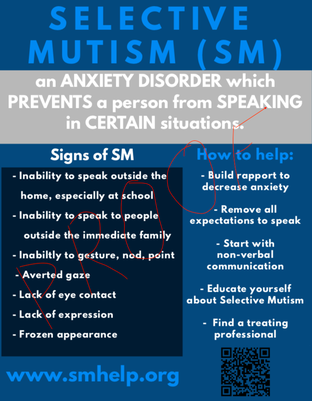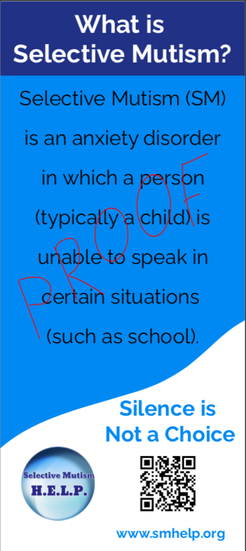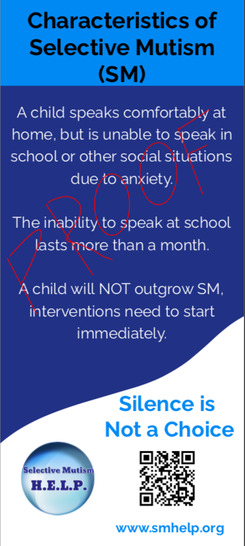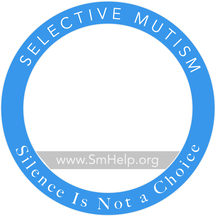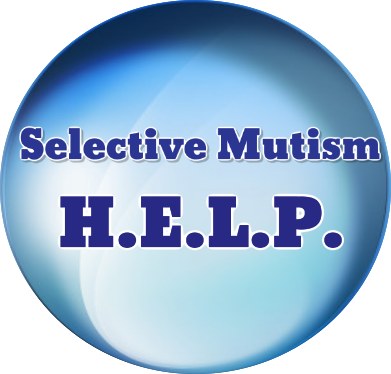What is Selective Mutism (SM)? |
Characteristics of SM
|
Appearance of SM in Children
|
|
After filling out this form, you will receive everything you see below emailed as PDF files to be able to share and distribute.
|
Downloadable Profile Frame
Common Comorbid Diagnoses
Generally speaking, there may be other disorders a child with Selective Mutism may be diagnosed with. Below is a list of the most common comorbid diagnoses.
- Social Anxiety/Social Phobia
- Separation Anxiety
- General Anxiety Disorder (GAD)
- Language Impairments/Disorders
- Sensory Processing Disorder (SPD)
- Autism Spectrum Disorder (ASD)
- Obsessive Compulsive Disorder (OCD)
Common Terms
Here are some common terms you may come across while researching Selective Mutism. There is more in-depth information in the "Parent Resources" and "Teacher Resources" pages..
Anxiety: your body's natural defense to stress; we all have anxiety, but to an SM child, the anxiety is extreme and can prevent them from speaking, gesturing, or making eye contact.
Behavioral Therapy: exposure with response prevention; teaching skills to manage and reduce anxiety.
CDI: Child Directed Interactions; reduces anxiety by removing the expectation for the child to speak; use PRIDE skills.
Cognitive Behavior Therapy: teaching the child to recognize their anxiety and that anxiety response is too high for certain situations; This modifies behaviors by redirecting anxious fears/worries into positive thoughts.
DSM-V: Diagnostic and Statistical Manual of Mental Disorders - 5th edition. This is a manual health care professionals use to assess and diagnose mental disorders. The fifth edition was released in May 2013.
Enabler: a person who encourages negative or self-destructing behaviors in another. Most parents unknowingly become enablers for continuing their child's SM. They see their child in distress so they naturally want to make that distress go away. They may start answering for their child or allowing them to answer questions through gesturing or head nods instead of answering verbally.
Exposure Therapy: a psychological treatment to help people confront their fears/anxieties.
Extrinsic Motivation: when someone becomes motivated by the use of a reward system or a valued incentive.
Forced Choice Question: the child must answer verbally based on choices given - Which do you like better, ice cream or pickles?
Habituation: the ability to return to regular functioning; SM kids need to understand the anxious feeling so they can appreciate what it feels like when it goes away. They will begin to understand that the anxious feeling will pass and it isn't a permanent state. This can be achieved through exposure therapy.
Individualized Education Program (IEP): must meet eligibility criteria to receive special education services. It is a legal document the school must follow which is specific to the child's needs based on an evaluation completed by the school. The IEP will contain specific, measurable short-term and long-term goals and objectives while allowing the child to stay in their regular classroom with non-disabled classmates. It will also list modifications or supports the student will need.
Intensive Camp: An intensive camp is an opportunity for kids with Selective Mutism to be in therapy over several consecutive days, instead of traditional therapy which may be done once weekly for several months. This could be an option for those that do not have an SM therapist in their state, or if a child needs the skills necessary to progress in the next school year. See SM Camps page for more information about camp options.
Intrinsic Motivation: when someone becomes motivated by their own internal drive to do well.
Negative Reinforcement: a behavior increases when something is taken away; when an SM child is expected to talk they get uncomfortable and avoid talking. If they aren't required to talk due to someone answering for them, for example, they are rewarded for not talking because the uncomfortable feeling went away which strengthens their SM.
Occupational Therapy: a form of therapy that uses every day life activities to help patients overcome physical or mental illness.
Open-Ended Question: the child must come up with a verbal response on their own - What is your favorite flavor of ice cream?
Play Therapy: using play to help children communicate their feelings; best for younger children.
Positive Reinforcement: the addition of an award following a desired behavior.
Pragmatic Language: the social language cues we use to communicate; includes what we say, how we say it, the appropriateness of a response, and non-verbal communication (eye contact, facial expressions, etc).
PRIDE acronym: Praise, Reflect, Imitate, Describe, Enthusiasm; used during CDI
Psychologist: a type of therapist that has extensive knowledge on mental processes and behavior.
S-CAT: Social Communication Anxiety Treatment Strategies developed by Dr. Elisa Shipon-Blum at the Smart Center in Pennsylvania. Click here for more information.
Section 504: Federal law that protects the rights of students with disabilities. It consists of a list of reasonable accommodations to give the child equal access to their education, no matter their disability. To qualify, an evaluation must be done by the school. This does not allow for any special services (speech, occupational therapy, social worker, etc) or goals and objectives.
Speech and Language Pathologist/Speech Therapist: therapists that understand communication, how communication is developed, and speech disorders.
Social Worker: professionals whose goal is to enhance a person's well being and help with basic and/or complex needs.
SSRI: Selective Serotonin Re-uptake Inhibitors; best type of medication to respond to anxiety disorders; Zoloft, Prozac, Celexa, Paxil, Luvox are common SSRIs used in treating children with SM. Always speak to a professional when prescribing any medication.
Stimulus Fading/Fade-In: a person the child does not speak to or a place the child does not speak in will be gradually introduced.
Successive Approximations: stages of communication to help with goal setting.
Systematic Desensitization: the process to reduce heightened responses due to anxiety; the child goes through various exposures at a slow pace to help stop the pattern of avoidance and to help motivate them to continue. They will learn ways to cope with their anxiety during the exposures which will help them when faced with more difficult exposures.
VDI: Verbalization Directed Interactions; the planned and intentional use of prompts in a graduated and systematic approach.
Behavioral Therapy: exposure with response prevention; teaching skills to manage and reduce anxiety.
CDI: Child Directed Interactions; reduces anxiety by removing the expectation for the child to speak; use PRIDE skills.
Cognitive Behavior Therapy: teaching the child to recognize their anxiety and that anxiety response is too high for certain situations; This modifies behaviors by redirecting anxious fears/worries into positive thoughts.
DSM-V: Diagnostic and Statistical Manual of Mental Disorders - 5th edition. This is a manual health care professionals use to assess and diagnose mental disorders. The fifth edition was released in May 2013.
Enabler: a person who encourages negative or self-destructing behaviors in another. Most parents unknowingly become enablers for continuing their child's SM. They see their child in distress so they naturally want to make that distress go away. They may start answering for their child or allowing them to answer questions through gesturing or head nods instead of answering verbally.
Exposure Therapy: a psychological treatment to help people confront their fears/anxieties.
Extrinsic Motivation: when someone becomes motivated by the use of a reward system or a valued incentive.
Forced Choice Question: the child must answer verbally based on choices given - Which do you like better, ice cream or pickles?
Habituation: the ability to return to regular functioning; SM kids need to understand the anxious feeling so they can appreciate what it feels like when it goes away. They will begin to understand that the anxious feeling will pass and it isn't a permanent state. This can be achieved through exposure therapy.
Individualized Education Program (IEP): must meet eligibility criteria to receive special education services. It is a legal document the school must follow which is specific to the child's needs based on an evaluation completed by the school. The IEP will contain specific, measurable short-term and long-term goals and objectives while allowing the child to stay in their regular classroom with non-disabled classmates. It will also list modifications or supports the student will need.
Intensive Camp: An intensive camp is an opportunity for kids with Selective Mutism to be in therapy over several consecutive days, instead of traditional therapy which may be done once weekly for several months. This could be an option for those that do not have an SM therapist in their state, or if a child needs the skills necessary to progress in the next school year. See SM Camps page for more information about camp options.
Intrinsic Motivation: when someone becomes motivated by their own internal drive to do well.
Negative Reinforcement: a behavior increases when something is taken away; when an SM child is expected to talk they get uncomfortable and avoid talking. If they aren't required to talk due to someone answering for them, for example, they are rewarded for not talking because the uncomfortable feeling went away which strengthens their SM.
Occupational Therapy: a form of therapy that uses every day life activities to help patients overcome physical or mental illness.
Open-Ended Question: the child must come up with a verbal response on their own - What is your favorite flavor of ice cream?
Play Therapy: using play to help children communicate their feelings; best for younger children.
Positive Reinforcement: the addition of an award following a desired behavior.
Pragmatic Language: the social language cues we use to communicate; includes what we say, how we say it, the appropriateness of a response, and non-verbal communication (eye contact, facial expressions, etc).
PRIDE acronym: Praise, Reflect, Imitate, Describe, Enthusiasm; used during CDI
Psychologist: a type of therapist that has extensive knowledge on mental processes and behavior.
S-CAT: Social Communication Anxiety Treatment Strategies developed by Dr. Elisa Shipon-Blum at the Smart Center in Pennsylvania. Click here for more information.
Section 504: Federal law that protects the rights of students with disabilities. It consists of a list of reasonable accommodations to give the child equal access to their education, no matter their disability. To qualify, an evaluation must be done by the school. This does not allow for any special services (speech, occupational therapy, social worker, etc) or goals and objectives.
Speech and Language Pathologist/Speech Therapist: therapists that understand communication, how communication is developed, and speech disorders.
Social Worker: professionals whose goal is to enhance a person's well being and help with basic and/or complex needs.
SSRI: Selective Serotonin Re-uptake Inhibitors; best type of medication to respond to anxiety disorders; Zoloft, Prozac, Celexa, Paxil, Luvox are common SSRIs used in treating children with SM. Always speak to a professional when prescribing any medication.
Stimulus Fading/Fade-In: a person the child does not speak to or a place the child does not speak in will be gradually introduced.
Successive Approximations: stages of communication to help with goal setting.
Systematic Desensitization: the process to reduce heightened responses due to anxiety; the child goes through various exposures at a slow pace to help stop the pattern of avoidance and to help motivate them to continue. They will learn ways to cope with their anxiety during the exposures which will help them when faced with more difficult exposures.
VDI: Verbalization Directed Interactions; the planned and intentional use of prompts in a graduated and systematic approach.
